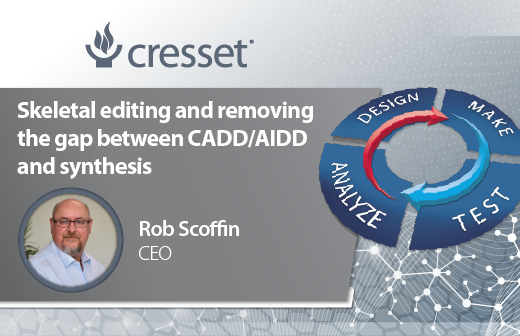In the fields of peptide and protein synthesis, there is a very efficient translation between design and synthesis – this operates generally via the mechanism of DNA synthesis, and then various expression platforms or through direct synthesis routes at the amino acid level. Whilst the ‘palette’ of building blocks is finite (23 naturally occurring amino acids, plus a similar number of non-naturally occurring ones which are regularly used in creating custom molecules), the ‘chemical space’ able to be explored through these structures is huge.
"You can imagine a world where you can design exactly the right molecule to go and attack that specific tumour, and you have a synthesiser where you can draw that molecule, click a button and it makes it. That opens up a huge world of possibility in terms of that kind of personalised precision medicine." - Rob Scoffin, CEO Cresset (‘Endless possibilities’: the chemists changing molecules atom by atom, The Guardian1)
In the field of chemical synthesis, this translation is actually much harder, whilst the palette of atoms is even further restricted (particularly if we are dealing with small molecules for drug discovery) to generally C,H,N,O,S,P,F,Cl,Br, the incredible flexibility of organic chemistry does mean that the theoretical chemical space of possible drug-like molecules is enormous. However, the translation of this immense theoretical chemical space into actual molecules is restricted by many aspects of chemical synthesis, including issues with yields, cost of starting materials and in many cases coming up with a viable synthetic route to the specific molecule of interest. Whilst these issues can sometimes be mitigated by synthesis of a closely-related molecule or series, it does still lead to a disconnect between computational chemists working in traditional computer-aided drug discovery (CADD) or data scientists and computational chemists working with Artificial Intelligence-Driven Drug Discovery (AIDD) tools and their synthetic chemistry colleagues or CRO partners.
In order to remove some of these barriers, there have been a number of interesting advancements – from massive improvements in retrosynthesis approaches (hugely influenced by the application of Deep Learning Neural Networks to the problem of searching for a route to a particular compound and/or the optimization of an existing synthetic route), to novel chemistries and catalysts, to an expanding field of ‘skeletal editing’ reactions which allow for the modification of structures at the single atom level.
I was recently interviewed for, and quoted in, an article in The Guardian1 which discussed the endless possibilities for chemists changing molecules atom by atom. The level of interest that this field has generated transcends the scientific literature by making a splash in the mainstream media! Underlying this is a wealth of high-profile publications, not least in Nature2,3 and others.4 The current state of the art provides a very limited set of tools for the synthetic chemist, but provides a very intriguing demonstration of capabilities and promises much more for future applications.
The Guardian’s article speculates on the future possibilities of customized or personalized medicines, but the near-term applications are equally interesting in that they narrow the gap between what the computational scientists can design using tools like Flare™,5,6,7,8 in terms of the ‘perfect’ molecule, along the lines of Paul Ehrlich’s original ‘Magic Bullet’ hypothesis,9 and what the synthetic chemists are able to make which should lead to better, safer and faster-to-market medicines.
This is a great example of scientific advances addressing not just specific technical issues, but also problems of human communication and interaction.
References
- ‘Endless possibilities’: the chemists changing molecules atom by atom, The Guardian
- ‘Almost magical’: chemists can now move single atoms in and out of a molecule’s core, Nature
- Skeletal editing through direct nitrogen deletion of secondary amines, Nature
- Molecular editing in natural product synthesis - Organic Chemistry Frontiers, RSC Publishing
- Flare™, Cresset®, Litlington, Cambridgeshire, UK; http://www.cresset-group.com/flare/
- Cheeseright T., Mackey M., Rose S., Vinter, A.; Molecular Field Extrema as Descriptors of Biological Activity: Definition and Validation J. Chem. Inf. Model. 2006, 46 (2), 665-676
- Bauer M. R., Mackey M. D.; Electrostatic Complementarity™ as a Fast and Effective Tool to Optimize Binding and Selectivity of Protein–Ligand Complexes J. Med. Chem. 2019, 62, 6, 3036-3050
- Maximilian Kuhn, Stuart Firth-Clark, Paolo Tosco, Antonia S. J. S. Mey, Mark Mackey and Julien Michel Assessment of Binding Affinity via Alchemical Free-Energy Calculations J. Chem. Inf. Model. 2020, 60, 6, 3120–3130
- Ehrlich, P. (1960), Experimental Researches on Specific Therapy, The Collected Papers of Paul Ehrlich, Elsevier, pp. 106–117, doi:10.1016/b978-0-08-009056-6.50015-4, ISBN 978-0-08-009056-6 [Reprint of 'Experimental Researches on Specific Therapy: On Immunity with special Reference to the Relationship between Distribution and Action of Antigens' from 'The Harben Lectures for 1907 of the Royal Institute of Public Health', London: Lewis, 1908]



